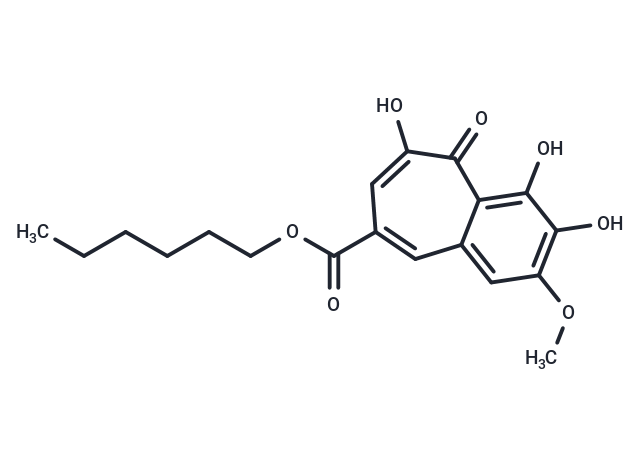Shopping Cart
- Remove All
 Your shopping cart is currently empty
Your shopping cart is currently empty

CU-CPT22 is the first probe for the complex between toll-like receptors TLR1 and TLR2. CU-CPT22 binds at the interface of TLR1 and TLR2 (IC50 = 0.58 μM). It competes with the synthetic triacylated lipoprotein (Pam3CSK4) binding to TLR1/2 (Ki: 0.41 μM).

| Pack Size | Price | Availability | Quantity |
|---|---|---|---|
| 1 mg | $44 | In Stock | |
| 2 mg | $64 | In Stock | |
| 5 mg | $101 | In Stock | |
| 10 mg | $171 | In Stock | |
| 25 mg | $329 | In Stock | |
| 50 mg | $493 | In Stock | |
| 100 mg | $718 | In Stock | |
| 1 mL x 10 mM (in DMSO) | $116 | In Stock |
| Description | CU-CPT22 is the first probe for the complex between toll-like receptors TLR1 and TLR2. CU-CPT22 binds at the interface of TLR1 and TLR2 (IC50 = 0.58 μM). It competes with the synthetic triacylated lipoprotein (Pam3CSK4) binding to TLR1/2 (Ki: 0.41 μM). |
| Targets&IC50 | TLR2/1:(ki)0.41 μM |
| In vitro | A novel compound (CU-CPT22) that can compete with the synthetic triacylated lipoprotein (Pam3CSK4) binding to TLR1/2 with high inhibitory activity and specificity.CU-CPT22 is a toll-like inhibitor of receptor 1 and 2 (TLR1/2) ( IC50: 0.58±0.09 μM).?CU-CPT22 is found to have no significant cytotoxicity at various concentrations up to 100 μM in RAW 264.7 cells.?It is showed that CU-CPT22 is able to compete with Pam3CSK4 for binding to TLR1/2 (Ki: 0.41±0.07 μM).?Which is consistent with its potency observed in the whole cell assay.?Increasing the concentration of CU-CPT22 to 6 μM decreases the anisotropy to background levels.?It is found that CU-CPT22 inhibits TLR1/2 signaling without affecting other TLRs, showing it is highly selective in intact cells.??The result shows that CU-CPT22 can inhibit about 60% of TNF-αand 95% of IL-1β at 8 μM[1]. |
| Molecular Weight | 362.37 |
| Formula | C19H22O7 |
| Cas No. | 1416324-85-0 |
| Smiles | CCCCCCOC(=O)c1cc(O)c(=O)c2c(O)c(O)c(OC)cc2c1 |
| Relative Density. | 1.336 g/cm3 (Predicted) |
| Storage | Powder: -20°C for 3 years | In solvent: -80°C for 1 year | Shipping with blue ice. | |||||||||||||||||||||||||||||||||||
| Solubility Information | DMSO: 125 mg/mL (344.95 mM) | |||||||||||||||||||||||||||||||||||
Solution Preparation Table | ||||||||||||||||||||||||||||||||||||
DMSO
| ||||||||||||||||||||||||||||||||||||

Copyright © 2015-2024 TargetMol Chemicals Inc. All Rights Reserved.